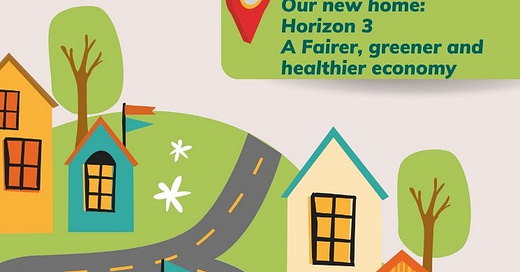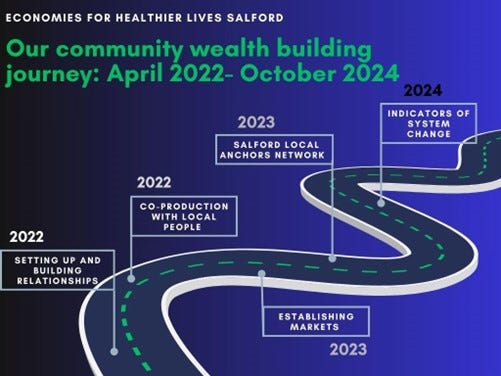How can you start to shift a whole system?
Addressing inequality involves considering several factors, from understanding the current systems and their impact on inequality to the strategies and tools that can drive meaningful change.
We use the Three Horizons framework to describe Salford’s journey in shifting the economic system through Economies for Healthier Lives. The Three Horizons framework provides a structured approach to envisioning economic system change, guiding us from our present circumstances (Horizon 1) through emerging shifts (Horizon 2) to a future vision (Horizon 3). By examining each horizon, we can identify what is worth conserving, what needs transformation or abandonment, and what a viable fairer, greener and healthier future might look like.
Over this series, we hope that we have conveyed why system change is needed and how community wealth building can help us to create fairer, greener and healthier places. In this chapter we will be sharing and exploring what Salford is learning from the perspective of each horizon.
Horizon 1: what is worth conserving?
Horizon 1 represents the current system and what is in place now. We recognise that many features of this system are unsustainable and do not work for everyone, There are, however, elements worth conserving as we move towards change. Locally, there are positive aspects of the current system that we recognise work well or are adaptable to create the future towards which we are working towards.
· Economic growth: Salford has the fastest growing economy in north-west England and is expected to experience the fastest percentage growth in Greater Manchester over the next two decades. The local economy is expected to grow by over 46% with £3 billion of growth. The city’s employment levels are set to increase by 16% in the next 20 years. The measures used to achieve this should not be abandoned if they work to benefit all Salford residents.
· Inclusive policy and strategy commitments: The Salford Way, the city’s approach to tackling inequalities, produced success in various areas. Examples include: 135 organisations now signed up to Salford City Mayor’s Charter for Employment Standards; over 100 organisations based in the city are accredited real Living Wage employers; and increased expenditure with suppliers based in Salford, ensuring more money stays in the local economy. Last year, Salford City Council spent £205 million on purchasing goods and services from its top 300 suppliers.
· Partnership working and cross sector collaboration: Salford is passionate about working together as partners to build a fairer, greener and healthier city. There are many successful existing partnerships that work to tackle inequality. The strong spirit of joint working and collaboration is a key factor in creating the right culture, which is worth conserving.
What does Horizon 1 look like in your place?
Can you recognise any strengths in the system that currently exists, whilst also acknowledging what needs to change and why?
Horizon 2: what is working from what we are trying and what are we letting go?
Horizon 2 represents the transitional phase and the innovations being tested to move on from existing only in horizon 1. Salford’s Economies for Healthier Lives project has been a key activity and innovation within horizon 2. Over this series, we have been sharing what that looks like, what we are learning, and how it might work for you. Some aspects we will be continuing with and others that have not gone exactly to plan:
· Greater connection between economic development and public health: A priority for this work was deepening the connection between public health and economic development professionals. Creating a new economic landscape in the city requires a better understanding of how this embeds health and well-being in its planning and execution. Through the project, we made introductions between teams, created spaces for joint work and often acted as a bridge between the two areas to share ideas, policy actions and focused work. These efforts have resulted in many positive outcomes such as strong relationships, shared visions and even spin-off projects around reimagining the purpose of town centres.
· Co-production between local people and agencies: Providing a space for local people and agencies to create solutions to changing the economy together was a priority for our work. We wanted to ensure that local people were an equal part of the solution and felt that they also had the power to change systems that would provide a better, fairer future for them and others. We facilitated the co-production by giving each group of local people space to form their ideas and commitment before supporting them to come together with agencies. Although our work is still ongoing, we have seen significant progress with milestones such as: identifying real market opportunities in the supply chains of local anchor institutions worth at least £10 million; local people developing social and co-operative businesses to provide goods and services to local anchor institutions; and negotiating tailored, sustainable contract terms to suit the new partnership between the new businesses and the local anchor institutions. You can refresh yourself on our co-production work in chapter 4 and chapter 9.
Figure 1: What Builds Good Health? (Health Foundation)
· Influence on policy and strategy: The focus of Economies for Healthier Lives has provided us with the space to test and develop ideas that can provide examples of how the system could change its practice to address inequality. The development of the Salford Local Anchors Network, examples of successful co-production between local people and agencies, and a greater understanding of how community wealth building can reduce health inequalities are all elements that are now featuring in policy and strategy such as Salford City Council’s Corporate Plan 2024-2028.
Identify approaches that would work in your place, build relationships and connections with people in the system you are trying to change, and test your ideas.
Horizon 3: what does a viable future look like for us?
Horizon 3 is the future vision we want to achieve through economic transformation. This future will exist as a result of innovation and system change. Horizon 3 is a long-term ambition, but we can share what we are working towards in a fairer, greener and healthier economy and the indicators that this viable future is in sight.
· Fairer distribution of power and wealth: More evenly distributed wealth across Salford is a key outcome that will create a fairer economy. As we know, Salford is experiencing positive economic growth, but historically it has not benefited everyone, with many areas still having low levels of wealth. Our work in community wealth building is creating examples how Salford can take steps to create an inclusive and green economy in which everyone can participate and thrive.
It is important to address issues around ownership and control when thinking about a more inclusive economy. This is often at the root of much of the disparity and can feel uncomfortable to confront. People from low-wealth areas often find it most difficult to access opportunities that give them more control over their futures, such as owning their own businesses, homes, land or buildings.
The creation of local businesses with a social purpose that which are owned by local people, such as those being set up through the Economies for Healthier Lives project, will act as examples of steps that can be taken to share opportunities for ownership and control and create pathways for anyone who may want to do this, especially those without the family connections or social capital. The recent change in national Government, together with local and national commitments to growing the social economy, are also indicators of change on its way
· Reduced health inequalities: We are now much clearer on the links between health and the economy. Our health and well-being is intrinsically linked to our socio-economic status. Our economic activity is linked to health and well-being, with poor health now being the leading factor in unemployment and long-term leave from work.
In a fairer, greener and healthier economy, more people participate in work they enjoy, which provides them stability and security. Self-employment and business ownership can provide groups facing barriers to employment (such as disabled people and people who have been through the criminal justice system) a chance to create an economic option for themselves that is better suited to their strengths and experiences.
We recommend learning from the Yunus Centre at Glasgow Caledonian University on the links between social business and health. Their evidence base highlights the health benefits to doing business with a social purpose on individual, community and systemic levels.
Workshop idea: imagining an inclusive and green economy
A participative activity:
People work in groups of 3-4 to imagine and draw what an inclusive and green economy would look like if creating and retaining wealth was done collectively in communities. This might be in people’s neighbourhood, town, city or region.
Imagine a fair, green and healthy economy in which there is social/collective ownership and control of local wealth and assets. What will this look like for future generations and/or designing a new neighbourhood/town/city?
Collect each group’s drawing and analyse into themes to understand what aspects of an inclusive and green economy are important to people.
This information can be used to inform future work, to share with stakeholders, or to offer as a basis for project ideas.
Next time:
Where are we going next?
Next chapter here:






